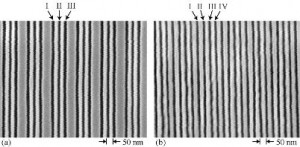“How can we fabricate something extremely small over large areas with high precision?” -Chih-Hao Chang
Nanomaterials have received significant interest across many research disciplines for unique properties not found at the macro scale. As exciting as these advances may be, the transition from exploratory prototypes in a research setting to commercial products is a difficult engineering challenge. To address these challenges, we explore novel/unconventional nanofabrication techniques based on both “top-down” lithographic and “bottom-up” self-assembly approaches. Such a hybrid approach combines the advantages of both techniques.
3D Nanolithography using Colloidal Assembly

One example is combining 2D colloidal self-assembly and phase lithography to fabricate complex 3D structures with designable lattice constants [1]. In this approach, the nanosphere array is assembled into an hexagonal array directly on top of the substrate. The sphere array generates a 3D Talbot field when illuminated, which is then captured by the underlying photoresist. Light scattering from particles, also known as Mie scattering, can also be utilized to generate interesting 3D nanostructures [2]. This approach replaces expensive optical components with self-assembled monolayer of nanospheres, allowing low-cost fabrication while maintaining pattern complexity.
Self-Assembled Ferrofluid Lithography

We have developed an active field-induced self-assembly process called self-assembled ferrofluid lithography (SAFLi), where magnetic nanoparticles are used as a tunable nanostructured mask for near-field lithography [3]. In this approach, shown in Figure 1, magnetic nanoparticles (~10 nm) in a carrier fluid, also known as ferrofluid, are used as fundamental building blocks. The particles, typically randomly dispersed in the solution, assemble to form ordered structures when external magnetic fields are applied. This technique allows the user to specify the particle assembly geometry, and therefore the shape of the “lithography mask,” by designing the external field.
Nanometrology

One important aspect of nanomanufacturing often overlooked is the precision of the fabricated structures. While some existing nanolithography approaches (such as electron beam, probed-based techniques, etc) may have high spatial resolution, their pattern placement accuracy over long distances can be magnitudes lower. Using optical interferometric techniques, we were able to measure and correct for placement errors with high precision. In the above figure three and four sets of grating lines were drawn in a serial process, demonstrating nanometer-level accuracy [4].
References
[1] C.-H. Chang, L. Tian, W. Hesse, H. Gao, H. J. Choi, M. Siddiqui, and G. Barbastathis, “From 2-dimensional self-assembly to 3-dimensional nanolithography,” Nano Letters, 2011, 11 (6), pp 2533–2537. [link]
[2] X. A. Zhang, J. Elek, and C.-H. Chang, “Three-Dimensional Nanolithography Using Light Scattering from Colloidal Particles,” ACS Nano, 7(7), 6212-6218, 2013. [link]
[3] C.-H. Chang, C.-W. Tan, J. Miao, and G. Barbastathis, “Self-assembled ferrofluid lithography: patterning micro and nanostructures by controlling magnetic nanoparticles,” Nanotechnology, 20 495301 (2009). [link]
[4] C.-H. Chang, Y. Zhao, R. K. Heilmann, and M. L. Schattenburg, “Fabrication of 50 nm period gratings with multilevel interference lithography,” Optics Letters, 33, 1572-1574 (2008). [link]